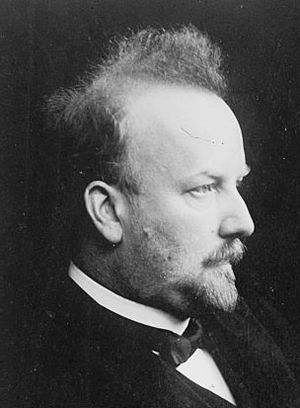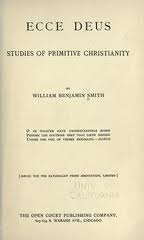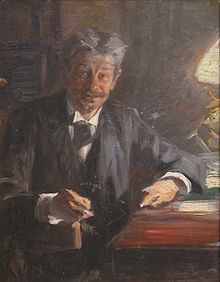 When starting this post I had hoped it would complete my discussion of Robert M. Price’s chapter, “Does the Christ Myth Theory Require an Early Date for the Pauline Epistles?” in ‘Is This Not the Carpenter?’. This was meant to address Price’s reasons for thinking that the gospel narratives of Jesus — or any stories of an earthly life of Jesus — first made their appearance well into the second century. I have sometimes argued the same, but Price does so from a quite different perspective (drawing on what we know of Marcion and early Marcionism) from anything I had considered.
When starting this post I had hoped it would complete my discussion of Robert M. Price’s chapter, “Does the Christ Myth Theory Require an Early Date for the Pauline Epistles?” in ‘Is This Not the Carpenter?’. This was meant to address Price’s reasons for thinking that the gospel narratives of Jesus — or any stories of an earthly life of Jesus — first made their appearance well into the second century. I have sometimes argued the same, but Price does so from a quite different perspective (drawing on what we know of Marcion and early Marcionism) from anything I had considered.
Before getting into Price’s argument some background was necessary. Unfortunately or otherwise, that background turned into a substantial post of its own, so here it is now. Price’s arguments for a second century creation of the gospels will have to wait. This post continues Price’s comparative study of early mythicist views of the relationship between Paul’s letters and the narratives of Jesus found in the gospels. Regardless of the date of Paul’s letters, this has long been the foundation of the Christ Myth theory.
As I pointed out in the first post on this chapter, Price discusses the views of today’s pre-eminent mythicists, G. A. Wells and Earl Doherty, noting their preference for the orthodox view of the Pauline epistles. That is, that they are written by “the genuine” Paul and thus belong to the middle of the first century, well before the gospels were penned.
It is now necessary to look at the earlier arguments for sake of comparison, as Price does.
.
Paul-Louis Couchoud

Paul-Louis Couchoud accepted the genuineness of Pauline letters “at least in their shorter, Marcionite editions”.
He argued that Marcion penned 2 Thessalonians and Ephesians (known originally as Laodiceans) , but also that he wrote the first gospel — after the Bar Kochba revolt (133 c.e.) — and lived to see other gospels expand upon his.
Price sees here a potential acceptance of the possibility that one could write “Pauline” letters that contained no hint of a historical Jesus even though one was aware of a narrative of such a Jesus. But Price also concedes that in this case there was little opportunity for biographical references to Jesus to appear in letters that were written in direct response to, or as commentaries upon, earlier letters (1 Thessalonians and Colossians.)
.
Edouard Dujardin

Edouard Dujardin saw the same discrepancy between the NT epistles and the gospels, but had a slightly different view of “a Pauline historical Jesus”. Dujardin understood Paul to have thought of Jesus as appearing in the form of flesh on earth only for the short time it took to act out the sacred drama. Paul knows nothing of a historical setting or persons involved, however.
We find nothing in these epistles except the abstract affirmation that Jesus was crucified. The only precise indication is contained in the First Epistle to the Corinthians, ii. 8, in which we read that Jesus was crucified by the demons. . . . St. Paul knew that Jesus was crucified, but was wholly unaware that he was arrested, that he was arraigned before one or several tribunals, that he was condemned, and that his death took the form of a judicial crucifixion. (Dujardin, Ancient History of the God Jesus, cited by Price, pp. 101-102)
To step aside for a moment from Price’s chapter, it is worth noting that a contributor to this blog, Roger Parvus, has also argued for a view at least similar to that of Dujardin. See his comment on a post dealing with Paul’s concept of Christ, and his earlier two comments disagreeing with Couchoud’s view of a heavenly crucifixion.
.
Arthur Drews

Arthur Drews dismissed the question of the authenticity of Paul’s letters as a question impossible to solve “for the simple reason that we lack any certain basis for its decision.” (cited by Price, but Drews’ book is also found online, see page. 169)
What was clear to Drews, however, was that “the Jesus painted by Paul is not a man, but a purely divine personality, a heavenly spirit without flesh and blood, an unindividual superhuman phantom. . . . a principle of redemption. . . . nor in any way historical facts, but something super-historical. . . . .” (Again, online, see pages 180, 204, 206)
If the Pauline epistles were placed before the gospels in the canon, “where they really belong. . .
hardly any one would think that Jesus, as he there meets him, was a real man and had wandered on the earth in flesh and blood . . . . would in all probability only find therein a detailed development of the “suffering servant of God,” and would conclude that it was an irruption of heathen religious ideas into Jewish thought.
Our theologians are, however, so strongly convinced of it a priori — that the Pauline representation of Christ actually arose from the figure of Jesus wandering on earth — that even M. Brückner confesses, in the preface to his work, that he had been “himself astonished” (!) at the result of his inquiry — the independence of the Pauline representation of Christ from the historical personality, Jesus.” (online p. 208)
For Arthur Drews, if the Pauline letters of the NT are genuine (that is, really were written by the missionary of the mid-first century), then the Jesus in them cannot have been a historical personality.
The way in which the supposed Jew Paul speaks of him is contrary to all psychological and historical experience. (Drews, The Witnesses to the Historicity of Jesus, cited by Price p. 103)
On the other hand, if the letters are not by such a Paul, but were written in the second century, then it is conceivable that the author thought of Jesus as being a “historical personality”.
This later period would have no difficulty in raising to the sphere of deity a man of former times who was known to it only by a vague tradition.
Price interjects here:
But if the letters are that late, late enough for the real historical facts to have passed from collective memory, are the epistles still to be dated earlier than the Gospels? Why would the spurious traditions collected in the Gospels have waited this long to rear their heads?
It is not inconceivable, Price writes, that a complete loss of memory of a historical Jesus was followed by a mythology of Jesus:
After all, we hypothesize that a number of myths have attached themselves to rituals in order to provide some sort of an explanation long after the original reason for the ritual has been forgotten.
.
A principle from Rudolf Bultmann
Price reminds us to consider the implications of Bultmann’s view that many sayings “of Jesus” originally circulated without any narrative context. This explains their sometimes awkward fit in their gospel narratives and some uncertainty as to their exact message. The narrative introductions to these sayings were subsequent additions.
 I pick up from some passing footnotes of Price and quote here relevant sections from Bultmann’s The History of the Synoptic Tradition:
I pick up from some passing footnotes of Price and quote here relevant sections from Bultmann’s The History of the Synoptic Tradition:
As a rule the ideal or symbolic character of the situation derives from the incongruity between the occasion and the pathos of the saying, e.g. Lk. 9:57-62; Mk. 3:31-35, 10:13-16. Sometimes it is quite plain how little the occasion could really have evoked the saying: how could Jesus see what individuals contributed, and how could he have known that the widow had given her all? How did Jesus know (Lk. 19:7-9) that the people murmured about his visit to Zaccheus, and in what situation and to whom were the words of v. 9 really spoken? Or again, did the hierarchy actually ask Jesus to forbid the praises of children (Lk. 19:39f. para.)? There is no need to say anything about apophthegms containing a miracle story (Mk. 11:20-25; Lk. 17:11-19). Hardly anyone will doubt that Mk. 1:16-20, 2:14, condenses into one symbolic moment what was in actuality a process, and finally we may say quite generally: a biographical apophthegm from its very nature is not an historical report — and that applies to Jesus as much as to any other historical personality. (p. 57)
Dominical sayings, or arguments from the discussions of the Church were given vividness by being set in a concrete scene, as was the fashion of the Rabbis. . . . The sayings have commonly generated the situation, not vice-versa. A clear example of this is the story of the feet-washing in John 13:14f., 12-15,. The evangelist has made us of this story in constructing Chapter 13, and has based it on Lk. 22:27 (or some similar saying) . . . . (pp. 47-48)
After demonstrating the artificial nature of the controversy dialogues (and their similarity to Rabbinic tales serving the same functions), Bultmann comes to a critical methodological point:
[C]ontroversy dialogues are all of them imaginary scenes. Therefore, however, we must keep away at first from the question whether Jesus sometimes healed on the Sabbath day, or whether he used a certain saying which we find in a Controversy Dialogue in a discussion with his opponents. Of course it is quite possible that he did; indeed, very probable; but the first question to be asked, methodologically speaking, must be about the literary form of the controversy dialogue, and its origin as a literary device. This is simply the question about the Sitz im Leben, which is not concerned with the origin of a particular report or a particular historical happening, but with the origin and affinity of a certain literary form in and with typical situations and attitudes of a community . . . (p. 40)
Sitz im Leben for Bultmann thus has a quite different meaning or application from anything we find in the works of Maurice Casey and others today. Bultmann’s point consigns the works of Casey et al to being methodological invalid. I got carried away with quoting Bultmann here. I can see I am going to have to do a few posts dedicated to his History of the Synoptic Tradition one day.
The point is that all of this is consistent with the arguments of Wells and Doherty when, as Price points out,
It is not hard to picture the sayings originating (à la Wells and Doherty) as comments by the epistle writers and only subsequently picking up added meaning by a supplied narrative context and added authority by a connection to Jesus.
Thus the Gospels would, logically, follow the epistles — regardless whether the epistles belonged to the first or second century.
.
A principle from David Strauss
Price draws another point from David Strauss:
[W]here we entertain two versions of a story (or two rival stories) and one is more spectacular than the other, the historian must reject the more spectacular as the more likely to have been made up to enhance the story’s hero. If the more spectacular version were first known, what would motivate anyone to fabricate the less impressive? (p. 104)
Price illustrates with a case discussed by Strauss. On the one hand we have a saying that the prophecy that Elijah must come before the appearance of the Messiah being fulfilled figuratively in John the Baptist; on the other we have a story of Elijah actually appearing atop a mountain when Jesus is made even more glorious than Moses was. So when immediately after actually seeing Elijah himself, the disciples ask Jesus to explain how it is that Elijah must first appear and Jesus replies that Elijah has already appeared figuratively in John, we know we have a problem. Had the story of the appearance of Elijah appearing literally been known first, then we cannot imagine how the story of Jesus claiming John was a mere figurative fulfilment of a (re-interpreted) prophecy ever arose afterwards. So the story of Jesus pointing to John the Baptist as the fulfilment of the prophecy must precede the development of the story of the appearance of Elijah himself.
(Aside: I understand the logic of this, but am not entirely comfortable with it. When we ask “What would motivate anyone to fabricate a less impressive story?” are we not appealing to the argument from ignorance fallacy? How do we explain Matthew’s replacement of Mark’s story of the Gerasene demoniac (with a legion of demons being cast from a fearfully raging lunatic into suicidal swine) with an anticlimactic statement that Jesus merely cast demons out of two men? Further, is not the argument an implicit rejection of the literary creativity of the first evangelist? It would mean, for example, that Burton Mack is completely off base with his suggestion that Mark drew the transfiguration scene from his own imaginative reinterpretation of the story of Moses as known via Philo. I don’t know if it is possible to think that Mark was both coping with problematic and contradictory oral traditions and creating a narrative from his literary consciousness and matrix at the same time.)
But back to Price’s point here. He takes the principle and applies it to a comparison of what we read in the epistles and in the gospels:
Claims of spiritual upheavals in unseen worlds are as old as the hills, and admittedly unverifiable. On the other hand, a bag full of stories of virgin births, angelic interventions, demon exorcisms, nature miracles and a resurrection from the dead? Well, that is more spectacular, hands down. . . . By this criterion, then, as I think Drews implies, the vaguer epistolary version still trumps the Gospel version as the earlier. And this remains true no matter when each text was written down. (pp. 104-105, my emphasis)
At this point Price brings in one exception in Paul’s letters, the account of what happened “the night Jesus was betrayed, when he took bread, etc”. The exception is cited as first being noted by Arther Drews and it is Drews’ argument that Price outlines. The full argument of Drews, with a lengthy footnote to other scholarship of his day, can be found on pages 175 and 176 of the online text.
.
William Benjamin Smith
 William Benjamin Smith was willing to accept the early date of the Pauline epistles on condition that one also allowed for interpolations. Two passages in particular that Smith argued were post-gospel historicizing insertions (the revelation of the Last Supper words and the appearances of the resurrected Jesus to the various apostles) are argued, Price notes, in great detail — see pages 146 to 157 of Smith’s online Ecce Deus.
William Benjamin Smith was willing to accept the early date of the Pauline epistles on condition that one also allowed for interpolations. Two passages in particular that Smith argued were post-gospel historicizing insertions (the revelation of the Last Supper words and the appearances of the resurrected Jesus to the various apostles) are argued, Price notes, in great detail — see pages 146 to 157 of Smith’s online Ecce Deus.
Here Price compares the far more conservative approach of G. A. Wells (and by implication, Earl Doherty). These authors argue the early date of the letters, including these passages (the resurrection appearances and the Last Supper words) as original. In the case of the Last Supper they stress that Paul says he acquired the information by revelation.
.
John M. Robertson
 John M. Robertson is another earlier Christ Myth theorist who held far more radical views of the possible dates of the Pauline letters than Wells and Doherty have done. To quote from the online version of Robertson’s Pagan Christs, pp. 236-237:
John M. Robertson is another earlier Christ Myth theorist who held far more radical views of the possible dates of the Pauline letters than Wells and Doherty have done. To quote from the online version of Robertson’s Pagan Christs, pp. 236-237:
The fact is that the higher criticism of the New Testament has thus far missed the way just as the higher criticism of the Old so long did, by taking for granted the general truth of the tradition. 1
It sought to found on the hollow fiction of the Exodus and the Mosaic legislation of the desert, when one intelligent glance at the Book of Judges might have shown that the tabernacle of the desert was a myth. In a similar way it clings to the conception of a preaching and cult-founding Jesus, when an intelligent perusal of the epistles of Paul can suffice to show that the preaching Jesus was created after they wore written.
1 An emphatic exception, certainly, must be made as regards the Pauline epistles, which by the late Professor van Manen and others are rejected as entirely spurious.
(How little has changed — it seems it has always been the case that New Testament scholars are way behind their Old Testament fellows in the critical arena.)
As Price comments, the implication is again that no matter how late one dates the Pauline epistles, one must conclude that the gospels came later.
Later Price returns to Robertson’s view again to note that he remained uncommitted on the question of the genuineness of the Pauline epistles, though leaning somewhat towards van Manen’s view. But either way, Robertson demonstrated that the epistles to the Corinthians definitely did not indicate any awareness of the gospel narratives:
- The claim in 1 Cor 15:3-9 that the resurrected Jesus appeared to 500 brethren would surely have been included in the gospel narratives had it been known by the evangelists;
- The claim that the resurrected Jesus appeared to the twelve apostles likewise cannot have been written with any knowledge of the gospel narratives since the latter had removed Judas from the scene leaving them eleven in number;
- The failure to mention the women witnesses also indicates lack of awareness of the gospel story;
- The mention of “all the apostles” is inconsistent with the mention of “the twelve”, so one of those passages cannot have been original to the text;
- The singling out for mention of James is inconsistent with the gospel accounts.
.
Georg Brandes

Price quotes Brandes’ words on the same theme in Jesus A Myth. (Not only does he believe the gospels must be long after the epistles, but he is quite prepared to question the authenticity of the letters, too.) I repeat them here slightly expanded (with my own emphases):
This Gospel [John] seems to have been produced in the first half of the second century. But as far as it is possible to tell, the gradually constructed and repeatedly edited compilations known as the Synoptic Gospels must be at least fifty years younger than the genuine parts of the epistles ascribed to Paul. (p. 42)
The epistles which bear his name, genuine or not, are far older than the Gospels. The author of these epistles had never seen Jesus, and he neither knows nor communicates anything at all about the real life of Jesus.
The man called Paul has a purely theological conception of Jesus. (p. 44)
The likelihood seems to be that only the epistles to the Galatians, the Romans, and parts of the first one to the Corinthians can be held genuine. . . .
Even if they should be older than the Gospels, the Pauline writings may well be antedated. And there are persons, like the Hollander Van Manen, who firmly maintain that nothing at all indicates the existence in the first century of an “apostle” preaching along the lines of thought ascribed to Paul. It seems probable that the establishment of larger congregations that were no longer Jewish, but purely Christian, did not take place until the second century. (p. 45)
.
L. G. Rylands
Price quotes passages from Did Jesus Ever Live? by Louis Gordon Rylands likewise expressing the view that “the Pauline writers” were interested only in the death and resurrection of Jesus. “A sufficient proof that what [Paul] taught was pure dogma” is that he had no wish to obtain any information on this subject from other men.
On page 26 he writes:
Not only in the Pauline Epistles, but in all the Epistles, there is not the faintest trace of any impression that had been made by any human personality. If the supposed impression had been made, the experience through which the disciples had lived in the company of Jesus would have been handed down and the thought of early Christians would have been full of them. But these early Christian writers never reinforce their arguments by anything they had heard that Jesus had done. He is never set before those to whom these Epistles are addressed as an example which they should follow in any human relationship, by pointing to his behaviour on some particular occasion. For the writers of these Epistles Jesus is not a man whose example other man could follow. He is the ‘Son of God’s love, in whom we have our redemption, the image of the invisible God, the firstborn of all creation.’
.
Or what if Paul were even earlier?
Robertson, Price points out, even remarked that if Paul belonged to an earlier generation than traditionally assigned to him — and this is not inconceivable if his figure of Jesus were a “nominal memory” of a distant Jesus ben Pandira of the Talmud — ca 100 B.C.) — the problem of the silence of Paul would remain.
What started out as a brief note of Robert M. Price’s main argument has turned into something much more comprehensive, if disjointed. Tried to rush something that to me was quite familiar and ended up with one more post to go to complete Price’s chapter and my concluding thoughts.
If you enjoyed this post, please consider donating to Vridar. Thanks!


What strikes me about the theory that there was no genuine Paul and no genuine Pauline letters from the first century, is that its case seems to lack some kind of solidity. It often seems to be approached from the point of view of seeking to demonstrate that it is not necessarily the case that we must date any of the Paulines to the first century. Then the assumption is made that we can (or even must) date them to the second century. But once that is done, it then requires us to date the Gospels even later into the 2nd century, along with documents like the Ignatian letters and 1 Clement, not necessarily on good arguments of their own but simply because they seem to show knowledge of the odd Pauline.
At the same time, a Sitz-im-Leben must be supplied for the second century Paulines, and this is where the solidity is lacking. Linking them with Marcion in some way is usually done with some very dubious and weak identification with Marcionite issues, while having to ignore the fact that clear and major Marcionite issues are entirely lacking. And because Gospel elements are also entirely missing, along with any sense of Jesus as an earthly person, various explanations are necessary to explain this, so that we end up pushing all sense of a human man’s story to the latter half of the second century, even as late as Irenaeus in the final quarter of the century.
I’m not saying that all this is impossible, although I’ve seen consequent arguments put forward that even Justin’s corpus is a forgery, and in extreme scenarios like this, it seems to me that the whole thing collapses under its own Rube Goldberg weight. Whereas, to me (and I’m not going to get into detailed arguments on it here), the more ‘orthodox’ viewpoint on Paul makes for a cleaner, more natural picture, one of evolution where everything more or less fits without having to be twisted and forced into unnatural and problematic positions. What I have yet to see is a strong case for seeing a first-century Paul and some of the corpus as too problematic to be accepted.
Yes, there are anomalies, minor (to me) considerations that need to be addressed, and given the state of the record with no early versions of documents, etc. not all of these are going to be satisfactorily resolved, but the “second century” theory faces anomalies of its own which seem far greater. I would liken it to the question of Q’s existence. Some claim we don’t need a Q, some claim that there are ways to overcome the problems in the Luke used Matthew scenario, but my point is that accepting a Q in some form is far cleaner, more natural and less problematic than the alternative (this has got nothing to do with Occam’s Razor which is misapplied here), and provides us with a comprehensive picture of the evolution of a movement. Why throw that out, if it is not necessary?
Why throw out a first-century Paul if it is not necessary, especially in favor of an alternative which is anything but compelling on its own?
Earl,
All of the Christ Myth theorists covered here are said to either accept the first century date of the (genuine) letters of Paul or are undecided and prepared to make their case for Christ not being historical either way. This is Price’s main point — regardless of when we place the epistles — and Robertson is prepared to make his case whether the the Pauline epistles originated B.C. or second century A.D. — the “pillar argument” of the Christ myth theory stands: the letters know nothing of the Jesus of the gospels and the Jesus we meet in the gospels is a later development than what we find in the letters.
I have not seen any arguments for a second century date that merely “assume” that because the epistles “can” be dated so late that they “are” so late. In fact, if we apply normative methods for dating texts then there is a very strong case for presuming the letters are second century: see Scientific and unscientific dating of the Gospels. The same method applies to the epistles, or to any ancient text.
Indeed, the first century dating of the Pauline epistles does raise questions — how to explain the absence of evidence for their impact in church history until the time of Marcion; if they had so little impact how did they survive through to the second century? A second century date at least situates them in a period when we know there was a sudden upsurge of competing legends about Paul (only two of which said he was a letter writer) — Acts of Paul and Thecla, Acts of the Apostles, Pastoral epistles, the Pauline canon all appear in the external evidence around the same time.
I don’t see any problem with redating 1 Clement and Ignatian letters if their current dating is the result of fitting them into the orthodox model. Either way, the ‘internal’ reasons for dating them only work by matching their internal evidence with the prevailing model.
But it is a mistake to assume that any of this is “hyper-scepticism” (I know you don’t use that word). In another context I quoted Emmanuel Pfoh saying:
A mistake scholars of the Old Testament made was to assume that tradition narrated in the texts was itself historical context of those texts. New Testament scholars continue to make the same assumptions. I even found one voice attempting to raise the alarm against this method as far back as 1904:
This is from an academic paper delivered in 1904 by E. Schwartz: “Uber den Tod der Sohne Zebedaei. Ein Beitrag zur Geschichte des Johannesevangeliums” (= Gesammelte Schriften V, 1963,48-123). It is cited in a 1991 chapter by Luise Abramowski, “The ‘Memoirs of the Apostles’ in Justin” pp.331-332 published in “The Gospel and the Gospels” ed. Peter Stuhlmacher.
I have never argued that the Pauline corpus was not genuine, but at the same time it is only fair that we do keep in mind that it did appear in the external record at the time of clearly fabricated letters and acts of Paul, and that we are also aware that in the ancient times in question writing collections of letters, with all the marks of verisimilitude, was an established literary art form. See my post on Rosenmeyer for a few details.
It is also worth being aware of the detailed arguments of the likes of van Manen. There indeed are several very un-orthodox-epistle like features about the letters.
There is also the question of the identity of Paul — an otherwise unknown figure in Christian history until we come well into the second century: as per Parvus, Detering and Price. Given the apparent concern the author of Acts had over explaining to readers his version of the origin of the name of “Paul” (vis a vis its significance in gnostic type literature) this is not a flippant question.
So the principle argument I can see commending the genuineness of the Pauline letters is a naive reading of their self-witness. There is no difference to the trajectory of Christian views of Christ — it remains the same, only relocated to a different generation.
But if the thesis of Christian origins points to an amalgam of the first century Christianities represented by Paul and Q, then yes, this model does fall apart. (But we know Christianity was more complex in origins than this anyway. Gospel origins and Christian origins are two distinct questions, of course.) I agree that Goodacre’s argument that “Luke did not find Matthew’s long speeches pleasing” is too simplistic, too much an ad hoc rationalization, to establish a case against Q. I find more interesting arguments made in another context (again in Old Testament studies) that examine texts in the context of wider literary practices of the day. One of these is the practice of apparently breaking up an earlier longer coherent single narrative into smaller units and scattering them through a new history as a number of different stories in order to create the impression that the author had far more sources than in fact he really did. I look forward to posting about this here some time.
Now I generally do accept or argue any points on the basis that the letters of Paul are authentic (as far as scholars widely agree on this) and belong to the first century. I also generally argue on the assumption that they were written by the genuine Paul (even though this image is, I suspect, fed by at least some of what we read in Acts and not entirely based on the epistles alone). The significant point in the questions I generally address is that they represent Christian ideas largely foreign to those found in the gospels.
At the same time I remain open to other possibilities for the reasons stated above. I don’t see these as arising from taking pointless liberties with what the evidence will allow or from any sort of “hyper-scepticism” (not that you spoke of this). There are reasonable arguments and methods that are consistent with how we treat evidence in other disciplines that do open up other possibilities.